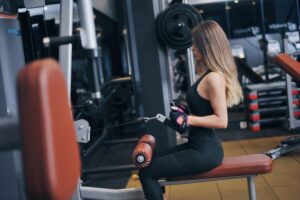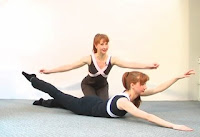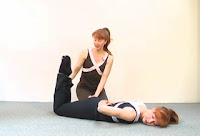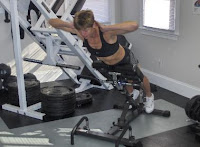 Why do you never forget how to ride a bicycle?* If you can forget people’s names, the triangle inequality theorem, or even where you put your car keys…then how the heck can you remember how to ride a bicycle, even after years of not doing so? The answer lies in our different types of memory. We have short-term memory, procedural memory, and even episodic memory, each one being stored in different regions of the brain. And while every form of memory within the human capacity is indeed fascinating, the type of memory I wish to share with you here is not a cognitive memory at all but physiological. It is called muscle memory.
Why do you never forget how to ride a bicycle?* If you can forget people’s names, the triangle inequality theorem, or even where you put your car keys…then how the heck can you remember how to ride a bicycle, even after years of not doing so? The answer lies in our different types of memory. We have short-term memory, procedural memory, and even episodic memory, each one being stored in different regions of the brain. And while every form of memory within the human capacity is indeed fascinating, the type of memory I wish to share with you here is not a cognitive memory at all but physiological. It is called muscle memory.
Muscle memory is well-known among athletes and bodybuilders, professional and amateur alike; any person who has spent time exercising, any time at all, believe it or not, has some experience with muscle memory. Simply put, muscle memory is a “detrained” muscle’s ability to regain size, strength and endurance upon retraining. To understand this completely, one must understand what happens during exercise, in this case, I wish to keep it to weight-lifting, although you can assume some overlap into other forms of exercise like yoga, swimming, Pilates and so on. I am referring mostly to forms of resistance training, but these principles apply to other forms of exercise (sports, flexibility training) to varying degrees as well.
When one contracts forcefully against resistance – gravity, weights, resistance bands, etc – the muscle fibers develop micro tears, a form of microtrauma, which the body then adaptively repairs the tissue and adds more fibers to essentially prevent further damage. This process of adding muscle fibers is called hypertrophy – trophy meaning “growth,” hyper meaning “above” or “beyond.” Hypertrophic muscle is what it means to be yoked or ripped in bodybuilding speak. It is essentially what most people wish to achieve, on some level, by lifting weights.
Now in my experience as a long-time health practitioner – with many clients seeing me for a decade or two – I find that very few people exercise consistently day in, day out, week in, week out, or year in, year out. This is not a flaw – it is life. Over the course of a decade, most people have new obligations, changing schedules, new relationships, babies, divorces, deaths of loved ones, and a whole multitude of other tragedies. Sometimes people just burn out – they need a break. Sometimes people get sick or injured. I have many clients who are extremely dedicated to their health and fitness, and not one person have I ever seen keep up exercise without a break in a ten-year period. I am not saying it doesn’t exist, just that it is extremely rare. Life happens.
Here is the point: If you have ever in your life exercised against resistance – that is, lifted weights, done calisthenics, or any sport requiring strength or bursts of speed – you have developed muscle memory, which will allow you to regain what you once had relatively quickly. The two important terms here are “what you once had” and “relatively.” First, it is crucial to understand that getting back to your pre-layoff size, strength and endurance should be fairly simple. You’ll have to return to your work outs slowly and smartly to prevent injury and coax the body back into its groove, but if you do things rightly, you will see your body morph over a short period back to how it once appeared. True, you might have stored some adipose (put on fat), and it won’t just melt away overnight, but the good news is that resistance training actually speeds up fat metabolism, so that lifting weights regularly will help you shed weight faster than diet or aerobic exercise alone. All three matter, but by doing resistance training along with the other two will burn the fat in the fastest possible way. And that is also why I say “relatively,” because, obviously, the rate at which your body returns to pre-layoff shape, size and strength will really depend on the duration of your layoff and the damage caused in that time (food, drugs, alcohol to be exact). So patience will matter in this endeavor, but the principle remains.
 I cannot emphasize enough this phenomenon of muscle memory and what it means for you. I am certain anybody who has ever seen their once-developed body slip into softness, but then returned to the gym, knows exactly what I am talking about. It doesn’t take long in most cases. One study showed that women who trained for 20 weeks (~ six months), then laid off (detrained) for 30-32 weeks (~ seven months), and then retrained for 6 weeks showed significant increases in cross-sectional areas of muscle fibers (size, girth) which also translated to strength and endurance. Interestingly, the same study found that the initial strength gained by the women during the initial training phase was not diminished much over the detraining phase.
I cannot emphasize enough this phenomenon of muscle memory and what it means for you. I am certain anybody who has ever seen their once-developed body slip into softness, but then returned to the gym, knows exactly what I am talking about. It doesn’t take long in most cases. One study showed that women who trained for 20 weeks (~ six months), then laid off (detrained) for 30-32 weeks (~ seven months), and then retrained for 6 weeks showed significant increases in cross-sectional areas of muscle fibers (size, girth) which also translated to strength and endurance. Interestingly, the same study found that the initial strength gained by the women during the initial training phase was not diminished much over the detraining phase.
This study shows that aside from the incredible ability of muscle to retain its size, strength, and endurance, even for people who have never worked out, a simple six month regimen of weight lifting exercise will create positive body changes that cannot be completely undone by an equally long layoff. So its worth every effort, even if incrementally. And, if you are like most people, when life twists and turns and you find the need to stop your exercise routine, you can rest assured that you will get back to where you left off quickly when you return to the gym.
I always try to impress upon clients, however, that while getting back to where you were last is relatively easy, taking your fitness to the next level is not – you have to work really hard to get to where you’ve never been. Keep that in mind. I am not trying to imply that developing your body to each successive level is easy. But I do wish to encourage you to keep with it (i.e. – get back to it…or start even) no matter what. Every time you exercise you are developing a little more toward your goal in mind, even if it doesn’t seem so in the moment. Muscle memory proves it. Your body develops and it remembers. So you are never wasting time by exercising – this should be encouraging to know that due to muscle memory, every workout matters.
*The bike thing is due to procedural memory



















